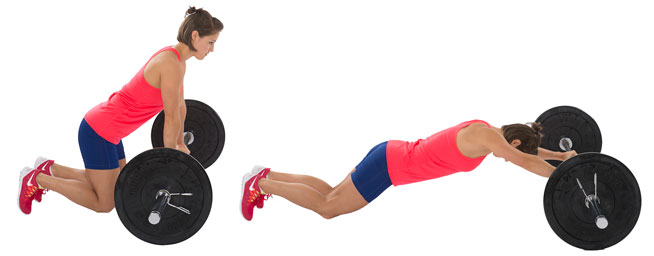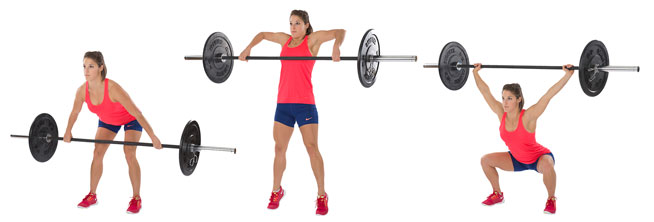Female Athletes: Get Strong, Not Bulky, With These Workouts
![]()
The number 1 misconception among female athletes, according to Ken Vick, director of high performance at STACK Velocity Sports Performance, is that weight training will make them look like a guy.
“Lifting heavy weights does not cause women to bulk up,” Vick says. “It’s extremely difficult for females to build muscle like males, because they have totally different hormonal profiles.”
Because they fear “getting big,” many young women waste their time in the weight room, performing toning workouts with tiny weights instead of doing the multi-joint exercises that build athletic strength. “Like any athlete, a woman needs to build functional strength that can be used on the field,” Vick says. His three keys for doing that:
1. Train Movements, Not Muscles
Not sure what is meant by “multi-joint exercises?” The term refers to exercises that require several joints in the body to move at once, like hips, knees and ankles all bending during a Squat. Exercises like this closely mimic the movements you perform in a game. Think about how squatting resembles the way you prepare to jump.
2. Build a Strong Base
Toned arms look great in tank tops, but hip and leg strength are what really matter to athletes. Check out the video player above to learn how to test your lower-body strength with strength and conditioning coach Todd Durkin. Building explosive strength in your lower body will help you run faster, jump higher, and protect you from injury.
3. Focus on Injury Prevention
Female athletes are six times more likely than males to suffer an ACL injury. Vick explains that although hormones play a role, the root cause is that most women have wider hips and (typically) weaker glutes and hamstrings. But you can fight back. How? By strengthening the muscles on the backside of your body and increasing your flexibility and range of motion.

Program Direction
- Perform the listed workouts once per week, resting one or two days between training sessions.
- Begin each workout with a dynamic warm-up and finish with a cooldown.
- Test your one-rep max on the first and third lifts of each workout and follow the specified weight percentages over the course of the program.
- For the second exercise of each workout, add 5 to 10 pounds of weight once you can perform 30 or more reps over three sets.
Featured Exercises
Barbell Rollout

Develops core strength, forcing your abs to resist extension as you roll the weight back and forth.
How to: Kneel behind a barbell with the bar in front of your thighs and grip it slightly wider than shoulder-width. Keeping your back flat and your arms straight, roll the bar forward as far as your core strength allows. Pull the bar back toward your body to return to the starting position.
Barbell Hip Bridge

Strengthens the glutes, the largest and most powerful muscles in your body.
How to: Lie on your back with your knees bent and your feet flat on the floor hip-width apart. Position a barbell across your hips and grasp the bar for support. Drive through your heels and extend your hips toward the ceiling. Slowly lower to the starting position.
Hang Power Snatch

This Olympic lift variation increases lower-body power, core stability and upper-body strength.
How to: Stand with your feet hip-width apart and hold a barbell with a wide grip. Push your hips back until the bar is just above your knees. Keeping the bar close to your body, explosively extend your hips, knees and ankles, and shrug your shoulders to pull the bar up. Drop into a squat position and catch the bar overhead with your elbows locked.
RECOMMENDED FOR YOU
MOST POPULAR
Female Athletes: Get Strong, Not Bulky, With These Workouts
![]()
The number 1 misconception among female athletes, according to Ken Vick, director of high performance at STACK Velocity Sports Performance, is that weight training will make them look like a guy.
“Lifting heavy weights does not cause women to bulk up,” Vick says. “It’s extremely difficult for females to build muscle like males, because they have totally different hormonal profiles.”
Because they fear “getting big,” many young women waste their time in the weight room, performing toning workouts with tiny weights instead of doing the multi-joint exercises that build athletic strength. “Like any athlete, a woman needs to build functional strength that can be used on the field,” Vick says. His three keys for doing that:
1. Train Movements, Not Muscles
Not sure what is meant by “multi-joint exercises?” The term refers to exercises that require several joints in the body to move at once, like hips, knees and ankles all bending during a Squat. Exercises like this closely mimic the movements you perform in a game. Think about how squatting resembles the way you prepare to jump.
2. Build a Strong Base
Toned arms look great in tank tops, but hip and leg strength are what really matter to athletes. Check out the video player above to learn how to test your lower-body strength with strength and conditioning coach Todd Durkin. Building explosive strength in your lower body will help you run faster, jump higher, and protect you from injury.
3. Focus on Injury Prevention
Female athletes are six times more likely than males to suffer an ACL injury. Vick explains that although hormones play a role, the root cause is that most women have wider hips and (typically) weaker glutes and hamstrings. But you can fight back. How? By strengthening the muscles on the backside of your body and increasing your flexibility and range of motion.

Program Direction
- Perform the listed workouts once per week, resting one or two days between training sessions.
- Begin each workout with a dynamic warm-up and finish with a cooldown.
- Test your one-rep max on the first and third lifts of each workout and follow the specified weight percentages over the course of the program.
- For the second exercise of each workout, add 5 to 10 pounds of weight once you can perform 30 or more reps over three sets.
Featured Exercises
Barbell Rollout

Develops core strength, forcing your abs to resist extension as you roll the weight back and forth.
How to: Kneel behind a barbell with the bar in front of your thighs and grip it slightly wider than shoulder-width. Keeping your back flat and your arms straight, roll the bar forward as far as your core strength allows. Pull the bar back toward your body to return to the starting position.
Barbell Hip Bridge

Strengthens the glutes, the largest and most powerful muscles in your body.
How to: Lie on your back with your knees bent and your feet flat on the floor hip-width apart. Position a barbell across your hips and grasp the bar for support. Drive through your heels and extend your hips toward the ceiling. Slowly lower to the starting position.
Hang Power Snatch

This Olympic lift variation increases lower-body power, core stability and upper-body strength.
How to: Stand with your feet hip-width apart and hold a barbell with a wide grip. Push your hips back until the bar is just above your knees. Keeping the bar close to your body, explosively extend your hips, knees and ankles, and shrug your shoulders to pull the bar up. Drop into a squat position and catch the bar overhead with your elbows locked.












